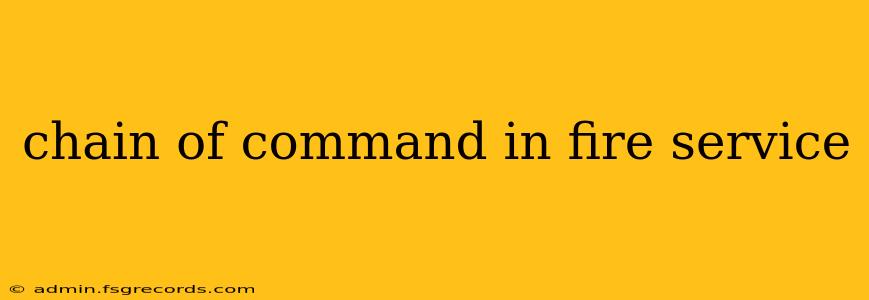The fire service operates under a strict and clearly defined chain of command. This hierarchical structure is crucial for effective incident management, ensuring swift and coordinated responses to emergencies, and maintaining safety for both firefighters and the public. Understanding this chain of command is vital, not just for firefighters themselves, but also for anyone working alongside or interacting with fire departments.
The Hierarchical Structure: From Chief to Recruit
The fire service chain of command typically follows a pyramidal structure, with authority flowing downwards from the highest-ranking official to the lowest. This structure varies slightly depending on the size and organization of the department, but the core principles remain consistent. Generally, the chain looks something like this:
1. Fire Chief (or equivalent):
The Fire Chief is the highest-ranking officer and ultimately responsible for the entire department's operations, administration, and strategic planning. They are responsible for setting the overall direction, managing budgets, and ensuring compliance with regulations.
2. Deputy/Assistant Chiefs:
Reporting to the Fire Chief are Deputy or Assistant Chiefs, who oversee specific divisions or branches within the department. This might include operations, training, prevention, or emergency medical services (EMS). They often manage larger teams and handle significant operational responsibilities.
3. Battalion Chiefs/District Chiefs:
These officers typically supervise multiple fire stations or geographic areas. They are responsible for overseeing daily operations within their jurisdiction, deploying resources effectively, and managing personnel during incidents.
4. Captains/Station Commanders:
Captains (or Station Commanders) are in charge of individual fire stations. They manage the daily activities, training, and equipment maintenance at their station. During incidents, they lead their crews and coordinate actions within the station's assigned area.
5. Lieutenants:
Lieutenants often act as the second-in-command at a fire station, supporting the Captain in all aspects of station management and incident response. They may also lead specific crews or take charge in the absence of the Captain.
6. Firefighters/Paramedics/EMTs:
These are the frontline responders, carrying out the tasks assigned by their superior officers. They operate under the direct supervision of their Lieutenants and Captains during incidents. Their roles range from fire suppression and rescue to providing emergency medical care.
Importance of Following the Chain of Command
Adherence to the chain of command is paramount for several key reasons:
- Effective Communication: It ensures clear and efficient communication, preventing confusion and misdirection during emergencies.
- Accountability: It establishes accountability for actions taken, facilitating investigations and ensuring appropriate responses to incidents.
- Discipline and Order: It maintains discipline and order within the department, contributing to a safe and productive work environment.
- Resource Management: It allows for efficient allocation and management of resources, including personnel and equipment.
- Safety: It prioritizes safety by ensuring that all actions are coordinated and supervised by experienced officers.
Exceptions and Flexibility
While the chain of command is rigid, there can be instances where flexibility is required, particularly during dynamic emergency situations. In high-pressure environments, senior firefighters may delegate tasks or give orders based on immediate needs. However, even in these cases, a post-incident debrief usually ensures that communication flows back up the chain of command, maintaining accountability and allowing for learning from the experience.
Conclusion
The fire service chain of command is a critical aspect of its organizational structure. It ensures effective incident management, maintains discipline, and ultimately protects the safety of firefighters and the public. Understanding this hierarchy is vital for anyone interacting with the fire service, enhancing communication and promoting collaboration in ensuring community safety.

